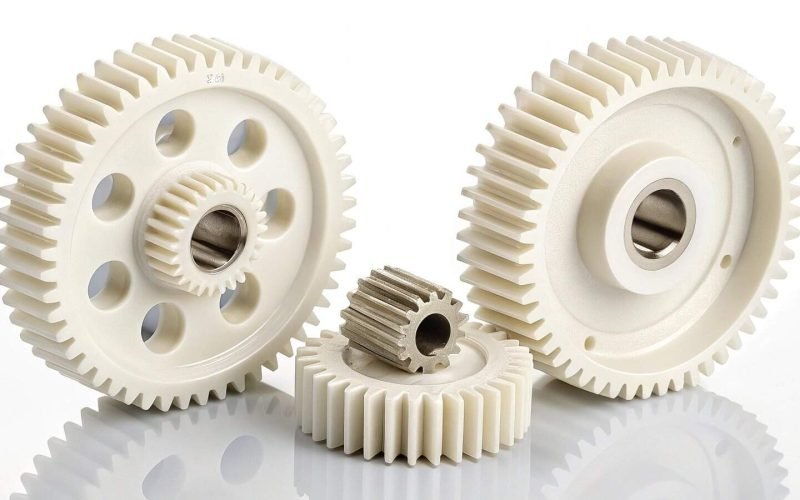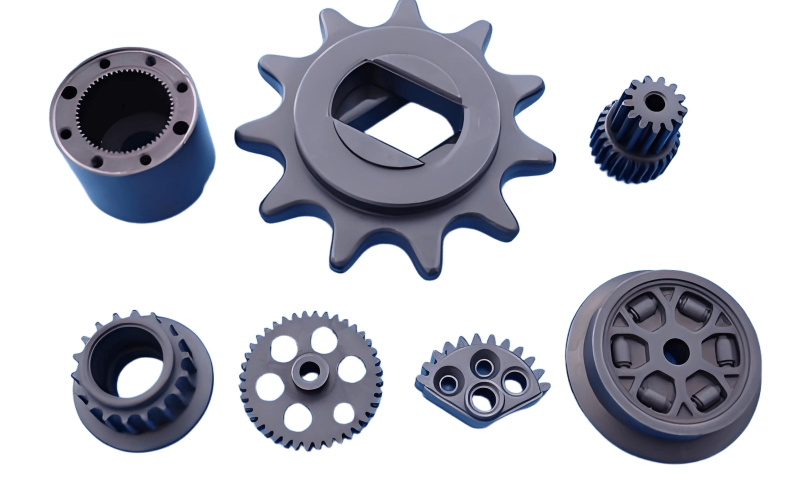Table of Contents
Did you know ceramic gears can handle temperatures hotter than a volcano and never rust? At Eshino Precision, we craft these super-tough gears from materials like alumina and zirconia to power machines in tough conditions. Whether you’re building food processors or airplane engines, ceramic gears are game-changers. This guide explains what they are, why they’re awesome, and how they compare to metal gears—all in a way a 12-year-old can understand!
Key Takeaway Table: Why Ceramic Gears Stand Out
| Advantage | What It Means |
|---|---|
| Super Strong | Handles heavy loads without breaking. |
| Heat-Proof | Works in heat up to 1750°C! |
| No Rust | Stays strong in wet or harsh places. |
| Lightweight | Lighter than metal for better efficiency. |
| Long-Lasting | Less wear means longer life. |
These perks make ceramic gears special. Let’s explore more!
What Are Ceramic Gears?
Defining Ceramic Gears
Why Are They Special?
Think of ceramic gears as superheroes. They can work in places where metal gears would melt or wear out. For example, they stay strong in hot engines or wet food factories. Their strength comes from how ceramics are made—super hard and smooth, like a polished stone. Plus, they’re lighter, so machines run better.
Materials Used
Most ceramic gears use alumina for its hardness or zirconia for extra toughness. Some even use silicon nitride for super-hot jobs. Each material is picked to match the job, like choosing the right tool for a project. At Eshino Precision, we customize gears to fit your needs.
“Ceramic gears are a leap forward for industries needing durability in extreme conditions,” says Dr. Jane Lin, a materials scientist at TechCeram Industries.

Why Choose Ceramic Gears?
Top Benefits Explained
Ceramic gears have awesome perks that make them stand out. First, they’re super strong, handling heavy loads without breaking. Second, they resist heat up to 1750°C—way hotter than metal gears can take. Third, they don’t rust, so they’re great for wet or chemical-filled places. Plus, they’re lightweight, making machines more efficient.
Real-Life Examples
Imagine a food factory where machines run in water all day. Ceramic gears keep going without rusting, keeping food safe. Or picture an airplane engine hotter than an oven—ceramic gears stay strong. They also wear less, so you don’t need to replace them as often, saving time and money.
Any Downsides?
Ceramic gears aren’t perfect. They can be brittle, like a hard candy that cracks if you drop it. So, they’re best for steady jobs, not ones with sudden bumps. But for the right job, their benefits are huge. Check out our blog on ceramic gear performance for more details!
“In high-wear environments, ceramic gears can outlast metal by years,” notes Dr. Lin.
Where Are Ceramic Gears Used?
Key Industries
Ceramic gears shine in tough spots. In food processing, they’re used because they don’t rust or contaminate food. In automotive, high-performance cars use them for speed and heat resistance. Aerospace loves them for hot engines, and textile machines use them for fast, wear-free work.
Specific Examples
In a yogurt factory, ceramic gears keep machines running smoothly in wet conditions. In a jet engine, they handle crazy heat. Even in precise tools like meters, they ensure accuracy. Their versatility makes them a top choice for advanced ceramic applications.
Why These Industries?
These industries pick ceramic gears because they need parts that last in harsh settings. Metal gears might rust or wear out, but ceramic gears keep going. Our product page shows how we tailor gears for your needs.

Ceramic Gears vs. Metal Gears: What’s the Difference?
Comparing Strengths
When choosing between ceramic gears and metal gears, it’s like picking between a tough glass cup and a bendy plastic one. Ceramic gears, made from materials like alumina or zirconia, are super hard and great for steady work. Metal gears, like those from steel, are tougher against sudden bumps. Let’s break it down with a table for clarity.
| Feature | Ceramic Gears | Metal Gears |
|---|---|---|
| Strength | Great for steady loads (2200 MPa compressive) | Better for impacts (1600 MPa flexural) |
| Weight | Light (3.65-6 g/cm³) | Heavy (7.85 g/cm³) |
| Heat Limit | Up to 1750°C | Up to 600°C |
| Rust | None | Can rust |
| Wear | Low wear, lasts long | Wears faster |
Why Choose One Over the Other?
Ceramic gears shine in hot or wet places, like food factories or jet engines, because they don’t rust and handle heat like champs. Metal gears are better for rough jobs, like heavy machinery that gets jolted. For example, a car engine might use ceramic gears for efficiency, but a construction crane needs metal for toughness. Our blog on technical ceramics dives deeper into material choices.
Expert Insight
“Ceramic gears offer unmatched wear resistance, but their brittleness means careful design is key,” says Dr. Jane Lin, a materials expert at TechCeram Industries. This means you need to match the gear to the job. At Eshino Precision, we help you pick the right one!
How Are Ceramic Gears Made?
The Making Process
Creating ceramic gears is like baking a super-strong cake. First, we mix ceramic powders, like silicon nitride or zirconia, with special ingredients to make them stick. Next, we shape them into gears using molds or presses, kind of like shaping cookie dough. Then, we bake them at crazy-high temperatures—over 1500°C—to make them super hard.
Finishing Touches
After baking, the gears get polished to be super smooth and exact. This step, called finishing, ensures they fit perfectly in machines. It’s a tricky process, but it makes gears that last a long time. Our blog on ceramic injection molding explains more about shaping ceramics.
Why It Matters
This careful process is why ceramic gears are so tough. It takes time and skill, but the result is a gear that can handle heat, wear, and tough jobs. At Eshino Precision, we use top-notch methods to make custom ceramic gears for your machines.
“Precision in manufacturing ceramic gears is critical for their performance,” Dr. Lin adds.
Are Ceramic Gears Worth the Cost?
Understanding Costs
Ceramic gears cost more than metal ones because of their fancy materials and complex making process. Think of it like buying a high-end phone—it’s pricey but packed with features. For example, raw materials like bentonite clay jumped from $67 to $94 per ton from 2018 to 2023. Add in the high-heat baking and polishing, and costs go up.
Why They’re Worth It
Even though they’re expensive, ceramic gears save money in the long run. They last longer in tough spots, like wet food plants or hot engines, so you replace them less. This cuts maintenance costs, as explained in our blog on reducing maintenance. The advanced ceramics market was worth $107 billion in 2023, showing they’re a smart investment.
Balancing Cost and Benefit
If your machine faces heat, rust, or wear, ceramic gears are worth it. For regular jobs, metal might be fine. We help you decide with our guide to choosing ceramics. It’s all about picking the right tool for the job!
Common Questions About Ceramic Gears
What People Want to Know
Got questions about ceramic gears? You’re not alone! Here are answers to common questions, explained simply so anyone can understand. These questions come from folks curious about how ceramic gears work and why they’re special. Let’s dive in!
- Are ceramic gears stronger than metal gears? Yes, for wear and heat! Ceramic gears, like those made from zirconia, are super hard and resist wear better. But they’re less tough against sudden hits, unlike steel gears.
- Where are ceramic gears used? They’re used in food machines, airplanes, fast cars, and even textile factories. Anywhere heat, rust, or wear is a problem, ceramic gears shine!
- Do ceramic gears last longer? In tough spots like wet or hot places, yes! They wear less, so they last longer than metal in those conditions. Check our zirconia durability guide.
- Why are ceramic gears pricey? They use special materials like alumina and need complex steps to make, like high-heat baking. That’s why they cost more.
- Can ceramic gears break? They can crack if hit hard, like a hard cookie. But for steady jobs, they’re super reliable.
Why These Questions Matter
These questions help you decide if ceramic gears are right for your project. For example, if you’re building a food processor, their no-rust feature is a big win. If you need gears for a bumpy machine, metal might be better. Our material selection guide can help you choose!
Expert Perspective
“Understanding the application is key to choosing ceramic gears over metal,” says Dr. Jane Lin, a materials scientist at TechCeram Industries. At Eshino Precision, we answer your questions to find the best fit.
The Future of Ceramic Gears
Exciting Trends
The future of ceramic gears is bright! Scientists are working to make them even better. For example, they’re finding ways to make ceramic gears tougher so they don’t crack as easily. They’re also using new tricks like 3D printing to cut costs. This means more machines could use ceramic gears soon!
Market Growth
The advanced ceramics market, which includes gears, was worth $107 billion in 2023 and is expected to grow 4.2% every year until 2030. That’s huge! Industries like automotive and aerospace are driving this growth because they need tough parts. Our blog on ceramic impacts explains more.
What’s Next?
Imagine ceramic gears in everyday cars or even robots! New designs mixing ceramics with metals could make gears that are both tough and long-lasting. At Eshino Precision, we’re ready to bring these innovations to you with our custom ceramic solutions.
“Innovations in ceramic manufacturing will make gears more accessible,” Dr. Lin predicts.
Conclusion
Why Ceramic Gears Matter
Ceramic gears are like superheroes for machines, offering strength, heat resistance, and no rust. They shine in tough spots like food factories, airplane engines, and high-speed cars. While they cost more and can be brittle, their long life and low maintenance make them a smart choice for the right job. The advanced ceramics market is booming, showing how much industries value these parts.
Your Next Step
Ready to power your machines with ceramic gears? At Eshino Precision, we craft custom gears to fit your needs, whether it’s for food processing or aerospace. Our team is here to help you choose the perfect ceramic gear for top performance.
Don’t wait to upgrade your equipment! Visit our product page to explore our ceramic gears or contact us today for a custom solution. Let’s make your machines stronger and longer-lasting with Eshino Precision!
External Resources
- Advanced Ceramics Market Size, Share, Growth Report 2030 – Learn about the growing ceramics market.
- Global Gear Market Size & Share Analysis – Insights into the gear industry.
- Technical Ceramics from Maxon – Explore ceramic manufacturing techniques.
Ready to Transform Your Engineering Solutions?
No industrial challenge is too complex for Eshino. From precision ceramic rods and advanced bushings to customized nozzles and other high-performance components, we engineer solutions that combine exceptional durability, thermal resistance, and precision to meet your specific needs. Whatever your industry demands, Eshino delivers tailored expertise you can trust.

